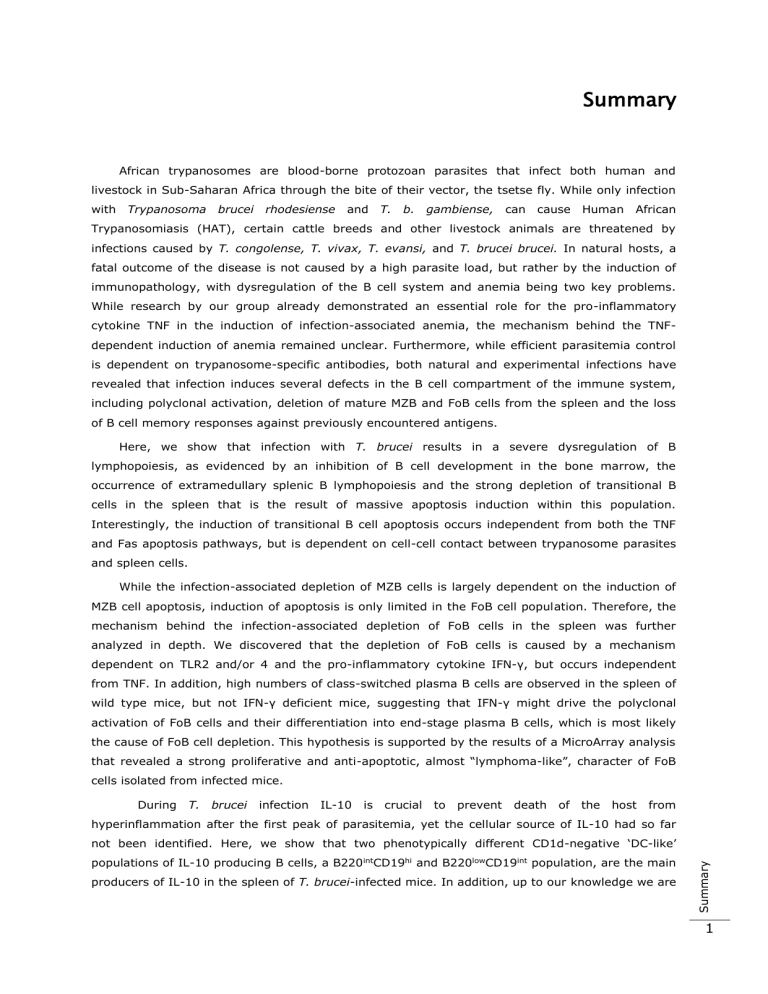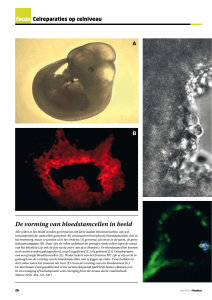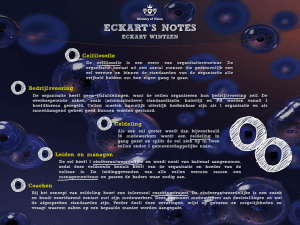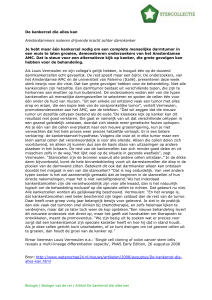
Summary
African trypanosomes are blood-borne protozoan parasites that infect both human and
livestock in Sub-Saharan Africa through the bite of their vector, the tsetse fly. While only infection
with Trypanosoma
brucei
rhodesiense
and
T.
b. gambiense,
can cause
Human
African
Trypanosomiasis (HAT), certain cattle breeds and other livestock animals are threatened by
infections caused by T. congolense, T. vivax, T. evansi, and T. brucei brucei. In natural hosts, a
fatal outcome of the disease is not caused by a high parasite load, but rather by the induction of
immunopathology, with dysregulation of the B cell system and anemia being two key problems.
While research by our group already demonstrated an essential role for the pro-inflammatory
cytokine TNF in the induction of infection-associated anemia, the mechanism behind the TNFdependent induction of anemia remained unclear. Furthermore, while efficient parasitemia control
is dependent on trypanosome-specific antibodies, both natural and experimental infections have
revealed that infection induces several defects in the B cell compartment of the immune system,
including polyclonal activation, deletion of mature MZB and FoB cells from the spleen and the loss
of B cell memory responses against previously encountered antigens.
Here, we show that infection with T. brucei results in a severe dysregulation of B
lymphopoiesis, as evidenced by an inhibition of B cell development in the bone marrow, the
occurrence of extramedullary splenic B lymphopoiesis and the strong depletion of transitional B
cells in the spleen that is the result of massive apoptosis induction within this population.
Interestingly, the induction of transitional B cell apoptosis occurs independent from both the TNF
and Fas apoptosis pathways, but is dependent on cell-cell contact between trypanosome parasites
and spleen cells.
While the infection-associated depletion of MZB cells is largely dependent on the induction of
MZB cell apoptosis, induction of apoptosis is only limited in the FoB cell population. Therefore, the
mechanism behind the infection-associated depletion of FoB cells in the spleen was further
analyzed in depth. We discovered that the depletion of FoB cells is caused by a mechanism
dependent on TLR2 and/or 4 and the pro-inflammatory cytokine IFN-γ, but occurs independent
from TNF. In addition, high numbers of class-switched plasma B cells are observed in the spleen of
wild type mice, but not IFN-γ deficient mice, suggesting that IFN-γ might drive the polyclonal
activation of FoB cells and their differentiation into end-stage plasma B cells, which is most likely
the cause of FoB cell depletion. This hypothesis is supported by the results of a MicroArray analysis
that revealed a strong proliferative and anti-apoptotic, almost “lymphoma-like”, character of FoB
cells isolated from infected mice.
During
T.
brucei
infection
IL-10
is
crucial
to
prevent
death
of
the
host
from
hyperinflammation after the first peak of parasitemia, yet the cellular source of IL-10 had so far
populations of IL-10 producing B cells, a B220intCD19hi and B220lowCD19int population, are the main
producers of IL-10 in the spleen of T. brucei-infected mice. In addition, up to our knowledge we are
Summary
not been identified. Here, we show that two phenotypically different CD1d-negative ‘DC-like’
1
the first to describe the occurrence of IL-10 producing regulatory T cells in the liver following T.
brucei infection.
Previous results obtained by our group have shown that vaccine-induced specific B cell
memory responses were lost in T. brucei infected mice that had been treated with diminazene
aceturate (DA). Therefore, it is essential to know whether treatment of T. brucei infection with DA
allows restoration of the infection-induced dysregulation of B lymphopoiesis in the bone marrow
and the depletion of transitional B cells and mature MZB and FoB cells in the spleen. We
demonstrate here that B lymphopoiesis in the bone marrow is fully restored within one week after
treatment, while a complete recovery of the transitional B, MZB and FoB cell populations was
observed in the spleen within three weeks after treatment.
While wild type mice suffer from severe T.brucei infection-associated anemia that starts
after the first peak of parasitemia is reached, TNF-/- mice suffer from much less anemia during
infection. Here, we show that TNF, signaling through TNF-R1, plays an essential role in the
induction of anemia following T. brucei infection by inducing erythrocyte trapping in the spleen that
is most likely the result of erythrocyte adhesion to VCAM-1, which becomes strongly upregulated
Summary
during infection by TNF.
2
Samenvatting
Afrikaanse trypanosomen zijn extracellulaire protozoa parasieten die zowel mensen als
vee infecteren via een beet van hun vector, de tsetse vlieg, in Afrikaanse gebieden onder de
Sahara. De menselijke vorm van Afrikaanse trypanosomiase wordt enkel veroorzaakt door
infectie met Trypanosoma brucei rhodesiense of T. b. gambiense parasieten, maar bepaalde
rundersoorten en vee worden bedreigd door infectie met T. congolense, T. vivax, T. evansi,
and T. brucei brucei species. In natuurlijke gastheren wordt een dodelijke afloop van de ziekte
niet
veroorzaakt
door
een
hoge
parasitemie,
maar
eerder
door
de
inductie
van
immunopathologie, waarbij dysregulatie van het B cel systeem en anemie twee belangrijke
problemen vormen. Hoewel onderzoek door onze groep reeds aangetoond heeft dat het proinflammatoire cytokine TNF een essentiële rol speelt in de inductie van infectie-geassocieerde
anemie, is het mechanisme hierachter nog niet duidelijk. Bovendien, terwijl efficiënte
parasitemie controle afhankelijk is van trypanosoom-specifieke antilichamen, hebben zowel
natuurlijke als experimentele infecties al aangetoond dat trypanosoom infectie verschillende
defecten in het B cell compartiment van het immuunsysteem veroorzaakt, waaronder
polyclonale activatie, deletie van mature MZB en FoB cellen in de milt en het verlies van B cell
geheugen tegen antigenen waarmee het lichaam reeds in contact was geweest.
In deze thesis tonen wij aan dat infectie met T. brucei resulteert in een dysregulatie van
de B cell ontwikkeling, wat de inhibitie van B cel ontwikkeling in het beenmerg, de inductie
van extramedullaire B cel ontwikkeling in de milt, als eveneens een sterke depletie van
transitionele B cellen in de milt inhoudt. Deze depletie van transitionele B cellen in de milt
wordt veroorzaakt door een sterke inductie van apoptose binnen deze populatie. Bovendien
blijkt de inductie van transitionele B cel apoptose onafhankelijk van de TNF en Fas apoptose
pathway te verlopen, en eerder veroorzaakt te worden door cel-cel contact tussen
trypanosome parasieten en milt cellen.
Terwijl de infectie-geassocieerde depletie van MZB cellen voornamelijk veroorzaakt wordt
door apoptose, blijkt de inductie van apoptose in de FoB cell populatie eerder beperkt te zijn.
Daarom hebben we het mechanisme achter de infectie-geassocieerde depletie van FoB cellen
hier verder uitgediept. We hebben ontdekt dat de depletie van FoB cellen wordt veroorzaakt
door een mechanisme dat afhankelijk is van TLR2 en/of 4 en het pro-inflammatoire cytokine
IFN-γ, maar onafhankelijk van TNF. Daarnaast werden grote aantallen “class-switched”
plasma B cellen waargenomen in de milt van wild type muizen, maar niet in IFN-γ-/- muizen.
cellen
en
hun
differentiatie
naar
eind-stadium
plasma
B
cellen
induceert,
wat
hoogstwaarschijnlijk de oorzaak van de FoB cel depletie in de milt is. Deze hypothese wordt
gesteund door de resultaten van een MicroArray analyse die aantoonde dat FoB cellen
Summary
Dit suggereert dat IFN-γ misschien de drijvende factor is van de polyclonale activatie van B
3
geisoleerd van geïnfecteerde muizen een sterk proliferatief en anti-apoptotisch, bijna
“lymfoma-achtig”, karakter hebben.
Tijdens T. brucei infectie is het anti-inflammatoire cytokine IL-10 essentieel om
hyperinflammatie te voorkomen na de eerste piek van parasitemie, wat tot de dood van de
gastheer kan leiden. Maar, tot nu toe was de cellulaire bron van IL-10 tijdens T. brucei infectie
nog onbekend. Hier tonen wij aan dat twee phenotypisch verschillende CD1d-negatieve “DCachtige’ populaties van IL-10 producerende B cellen, een B220intCD19hi en een B220lowCD19int
populatie, de belangrijkste producenten van IL-10 zijn in de milt van T. brucei geïnfecteerde
muizen. Bovendien zijn wij, voor zover we weten, de eerste om de aanwezigheid van IL-10
producerende regulatorische T cellen in de lever tijdens T. brucei infectie te beschrijven.
Resultaten behaald door onze groep hebben in het verleden aangetoond dat vaccingeïnduceerde specifieke B cell geheugen responsen verloren gaan in T. brucei geïnfecteerde
muizen die behandeld waren met diminazene actetaat. Daarom is het belangrijk te weten of
een behandeling van T. brucei infectie met diminazene acetaat een volledig herstel toelaat van
de infectie-geinduceerde dysregulatie van de B cel ontwikkeling in het beenmerg en de
depletie van transitionele B cellen en mature MZB en FoB cellen in de milt. In deze thesis
tonen wij aan dat de B cel ontwikkeling volledig hersteld is binnen één week na behandeling,
terwijl een volledig herstel van de transitionele B, MZB en FoB cel populaties in de milt werd
waargenomen binnen de 3 weken na behandeling.
Terwijl wilde type muizen lijden aan een erge vorm van anemie tijdens T. brucei
infectie die start nadat de eerste piek van parasitemie is bereikt, lijden geïnfecteerde TNF-/muizen aan veel minder anemie. Hier tonen we aan dat TNF, via TNF-R1 signalisatie, een
essentiële rol speelt in de inductie van anemie tijdens T. brucei infectie en verantwoordelijk is
voor de inductie van erythrocyt verstrikking in de milt die hoogstwaarschijnlijk veroorzaakt
wordt door de adhesie van erythrocyten aan VCAM-1, wat sterk opgereguleerd wordt tijdens
Summary
infectie onder invloed van TNF.
4












